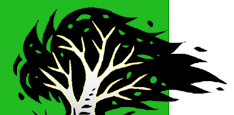NSF Proposal - 4. "Deep" Problems in Green
Plant Phylogeny
Current topology of the green plant tree (Fig. 1) arises from considerable
morphological and ultrastructural data that have accumulated over
the last three decades (e.g. [14-26]), and from the molecular tools
that have been applied at many levels (e.g., [27-41]). Many recent
advances reflect innovations in data gathering and analysis that
have resulted from increased coordination of effort among different
laboratories (see Management section). Despite these advances, several
nodes in the "deep" phylogeny? remain unresolved (Fig.
1). We propose to resolve these problematic nodes.
Ambiguity in the origin of green plants.
It is generally accepted that there are two principal clades of
green plants: the streptophytes, consisting of the land plants and
the green algae most closely related to them, and the chlorophytes,
containing most of the remaining green algae. At the base of these
two clades is a "residuum" consisting of unicellular "prasinophytes".
These algae are regarded as ancestral within the green plants, on
the basis of morphology and ultrastructure (e.g. [42]), nuclear
gene sequences (e.g. [43, 32, 44]) and organelle genome features
[45-48]. However, the relationships among the prasinophytes have
been difficult to recover. One species only, Mesostigma viride,
has been placed with some confidence at the base of the streptophytes
[49, 50]. Most of the remaining prasinophytes have been placed at
the base of the chlorophytes, but without clear affinities to any
other chlorophyte lineage [44].
Which are the most ancestral prasinophytes? The "phycomate"
prasinophytes (those with large, thick-walled floating stages, or
"phycomata") are candidates. They have ultrastructural
features common to both the chlorophyte and streptophyte lines [42],
they are the only green algae with mixotrophy (nutrition by both
photosynthesis and phagotrophy [51]), a presumptive precondition
for endosymbiosis of chloroplasts, and they have a fossil record
extending to the latest Precambrian and perhaps much earlier [52].
One extant genus, Tasmanites, has a fossil record dating back =600
million years, making it the oldest of all green plants [53, 54].
To test this result, we will incorporate a phycomate prasinophyte,
Pterosperma, into our primary analysis, and attempt concatenation
of our results with ongoing research on living (collaboration with
Fawley) and fossil (collaboration with Knoll) prasinophytes. 0228655
_05_0001.jpg)
Figure 1. Outline phylogeny
of the green plants, indicating the currently understood phylogenetic
position for 51 candidate exemplar organisms (represented by generic
names; see Table 1) and the higher-level taxa to which they are
thought to belong. All branches are subject to further testing,
but the best- supported branches with current data are indicated
with a thick line, branches with some support are indicated with
a thin line, and areas of the tree that remain controversial are
indicated by labelled ovals. See text for further explanation: 1.
Base of green plants: outgroup relationships and basal branching
among prasinophytes. 2. Relationships among major lineages of Chlorophyta
(some groupings are more firmly established, e.g. Ulvales/Ulotrichales,
Chlorophyceae/Trebouxiophyceae). 3. Relationships among the siphonous
algae and their placement in the Chlorophyta. 4. Base of the land
plants. 5. Base of the ferns (moniliforms).
To identify the ancestral prasinophyte, we need to define outgroups
for green plants. Many recent gene-sequence trees indicate that
the green plants are most closely related to the red algae and the
glaucocystophytes, the other two groups of algae that appear to
have gained their chloroplasts through a primary endosymbiosis with
a cyanobacterium [55]. However, red algae and glaucocystophytes
differ significantly from each other and from green plants in key
morphological, reproductive and ultrastructural features, so much
so that homologies are difficult to establish (e.g. [42]), and the
molecular results have been questioned (e.g. [56]). The most ancient
green algae have organellar genomes that may be more ancestral (more
like eubacteria) than those in the red algae examined to date [57,
45-48]. We will test the idea that red and glaucocystophyte algae
represent the proximal outgroups for green plants by incorporating
published data from selected representatives of these outgroups
into our analyses, and by interacting with colleagues who will be
conducting research on potential outgroups from among both algae
and protozoa (collaboration with Lang).
The Ulvophyceae. The Ulvophyceae
is one of the 3 classes currently recognized in the chlorophyte
lineage, the others being Chlorophyceae and Trebouxiophyceae (formerly
Pleurastrophyceae; [58]). Most members are marine, and the majority
of green "seaweeds", including well-known species of Ulva,
Acetabularia and Caulerpa, are placed in this class. Conversely,
the Chlorophyceae and Trebouxiophyceae, and the streptophytes, consist
almost entirely of non-marine organisms. In classifications based
on morphology and ultrastructure [59, 60, 42], the Ulvophyceae have
been separated from other chlorophytes mostly on the basis of characters
associated with mitosis, cytokinesis, and the flagellar apparati
of zoospores and gametes. In molecular analyses, however, the relationships
among these three classes are less clear [61]. Moreover, the "siphonous"
orders of Ulvophyceae (Cladophorales, Dasycladales, Caulerpales)
are difficult to resolve vis-à-vis each other and with other
Ulvophyceae (orders Ulotrichales and Ulvales); phylogenetic trees
based on single gene sequences reveal long branch lengths between
"siphonous" sequences and those of other chlorophytes
[59, 62] (O'Kelly unpublished, Friedl unpublished).
Are Ulvophyceae as conceived by Floyd and O'Kelly [64] monophyletic,
and how are ulvophyte clade(s) related to other chlorophytes? We
think it possible that the "siphonous" "ulvophyceae"
represent a clade separate from, and basal to, the remaining chlorophytes
(Chlorophyceae, Trebouxiophyceae and non-siphonous "Ulvophyceae").
We will test this idea by incorporating both siphonous and non-siphonous
Ulvophyceae, together with representative Chlorophyceae and Trebouxiophyceae,
into our large-scale analysis, and attempt concatenation of our
results with those from other ongoing research on ulvophytes (O'Kelly
ulvophyte grant). Some algae in our large-scale investigations,
particularly Acrochaete, Blastophysa, Bolbocoleon, Halochlorococcum,
Ignatius, Ostreobium, and Trentepohlia, we selected because very
recent research (O'Kelly and Friedl, unpublished) suggests they
may break up some of the long ulvophyte branches.
The "bryophytes" - early
embryophyte radiation. There is no consensus as to the primary
branching patterns at the base of the land plants. Molecular and
morphological evidence [63-67, 25] suggests that either hornworts
or liverworts are the oldest living lineage of land plants. In the
?hornworts- basal? hypothesis, a moss + liverwort clade is typically
supported. In the ?liverworts-basal? hypothesis, all three main
bryophyte lineages are paraphyletic, with either hornworts or mosses
sister to the vascular plants. Fossil evidence supports the liverworts-basal
hypothesis, as the first unambigous hornwort fossils date to the
Cretaceous and liverwort fossils to the Devonian. However, ornamentation
of Paleozoic spores from the Silurian (>410 Mya) are comparable
to that of Anthoceros, raising the possibility that hornworts were
the first bryophyte lineage to appear. Monophyly of the mosses is
widely accepted, but the interrelationships among the four major
moss lineages are unresolved. The hornworts are undoubtedly monophyletic
but within-group phylogeny has not been fully explored. Liverworts
are highly diverse and interrelationships are ambiguous to the extent
that monophyly of the group is questionable. DNA sequence data have
been equivocal, supporting a number of conflicting branching orders,
in part due to poor taxon sampling or limited sequence lengths [68-70,
66, 35, 24, 39]. Our large-scale analysis is likely to resolve the
bryophyte tangle.
The basal vascular plant radiation.
Within the tracheophytes, the lycophytes are sister to all other
tracheophytes (e.g., [71, 72]), a result supported by analyses of
both morphological and DNA sequence data. A comprehensive analysis
of morphological and molecular characters in basal tracheophytes
[36] produced the topology: (lycophytes (((Psilotum + ophioglossoid
ferns) + (Equisetum + marattioid ferns + leptosporangiate ferns))
+ seed plants)). This novel topology unites horsetails together
with all ferns as a monophyletic group that is sister to seed plants
and refutes the earlier view that horsetails are transitional evolutionary
grades between bryophytes and seed plants. This conclusion was supported
consistently by data from morphology and spermatogenesis [73, 24,
25]. The sister relationship of Psilotum with ophioglossoid ferns,
which was suggested previously (e.g., [74, 70, 75, 76]), is now
strongly supported [36].
[previous] [next]
|





